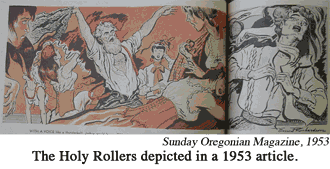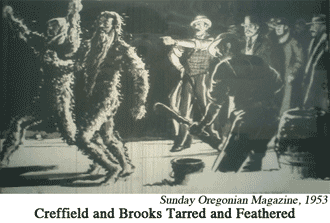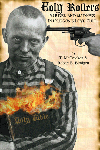Stewart Holbrook first wrote about Edmund Creffield for the Oregonian in 1936. Over the next twenty years he published several variations of that article. Unfortunately, while his version of events is fun to read, it’s not entirely factual. Still, since his accounts were widely read, no list of articles about the Holy Rollers would be complete without including one of his.
I’ve selected a series that appeared in four consecutive Sunday Oregonian Magazines in 1953. The reason I selected them is that I think they were read by many in Waldport, and it was the first time many had heard the story.
When I first started researching the Holy Rollers I asked a woman who knew all the gossip in town what she knew about Edmund Creffield. She said she hadn’t heard of him. “Wait, do you mean Joshua the Second?” “Yes,” I said. She said that when she was in high school in the 1950s a student at Waldport High School passed around an article he found and said, "Do you know who these people are? Whose mothers these are? Whose fathers these are?" Everyone at school knew who they were because everyone in town knew who they were. They were some of the town's earliest settlers and some of the town's best-respected citizens.
Holbrook, Stewart. Sunday Oregonian Magazine. “Murder Without Tears, Part One” 8 February 1953. pp.
6-7.
Murder Without Tears
First of Four Parts
By Stewart Holbrook
Portland Author
 __
__
The quiet college town of
Corvallis 50 years ago produced a self anointed prophet who called himself Joshua the Second. He rapidly gathered a cult of
followers, predominantly women. But his weakness for the ladies brought him a
violent death.
__
There can be little question
regarding the pre-eminence of southern California as a fertile ground for the
founding and growth of cults.
There is something unreal
about its climate that inevitably attracts both fanatics and phonies, just as
it inevitably attracts their followers of gulls.
Southern California has
whelped a number of notable cult-leaders, chiefly females. One such, a Mrs. Tibbetts, was burning incenses as early as 1986.
She may well have been the
first of her kind in the region. Since her day, the region has occasionally
known a shortage of water, but never a shortage of cults.
We Oregonians, however, need
not hang our heads because we are of late years comparatively barren of seeresses and prophets.
Less than 50 years ago we
had a prophet of Old Testament size, a mighty man beside whom all cult-leaders
of California, both male and female, were and are nothing. I sing here of
Joshua the Second.
He was born Franz Edmund
Creffield. Just when he was transformed from obscure rural evangelist into a
true Prophet is not known. Neither is the exact spot where the visitation took
place.
But the time is certain. It
was 1903, and the neighborhood of the miracle was Corvallis.
Great workings both material
and spiritual follow in the wake of a prophet, as naturally as water runs
downhill. If the prophet has a set of fine whiskers and a chronic case of satyriasis,
then the workings are certain to be multiplied and likewise interesting.
Oregon’s Joshua the Second
had both the whiskers and the affliction. And when he raised his voice in holy
anger, as he did on one remembered occasion, the vast city of San Francisco
shook horribly., then went down writhing and smoking,
in one of the great disasters of modern times.
In other words, the Oregon
Prophet was no man to monkey with.
***
Unheralded either by pillars
of fire or by a notice in the local weeklies, Creffield made his first Oregon
Appearance in Corvallis as a Salvation Army worker. He was 35, smooth-shaven,
short of stature. His eyes were large and dark brown. He retained a slight but
noticeable accent from his native Germany.
Early in 1903, he either
left or was discharged from the religious group, and seems to have disappeared
for a time.
I like to think it was
during this obscure period that the great light beat upon him and somewhere in
the tall forests that hedged the town, and he emerged a full-blown prophet. In
any case, he was soon back in Corvallis.
 Fifty years ago no man
without a beard could get into the prophesying business, and when Creffield
came of the Benton county timber he was wearing an astonishing growth. It was
of the true Moses type, flowing down over his chest and spreading to right and
left, unruly, wild; while over his shoulders tumbled
falls of unkempt hair.
Fifty years ago no man
without a beard could get into the prophesying business, and when Creffield
came of the Benton county timber he was wearing an astonishing growth. It was
of the true Moses type, flowing down over his chest and spreading to right and
left, unruly, wild; while over his shoulders tumbled
falls of unkempt hair.
He was, you will understand,
Edmund Creffield no longer, but Joshua the Second --sole prophet and for a
short time sole communicant of a startling new sect.
Even the tone of his voice
had changed. It no longer was that of a humble street evangel. It now boomed
like muffled thunder and in it, so many came to think, was the authority of a
spokesman for Jehovah.
***
Within a few weeks this
brand-new Joshua had collected a sizable group of converts. It was done so
quietly that even the town fathers of Corvallis, who fancied they knew
everything that went on locally, were wholly unaware of the great harvest of
souls that was going forward.
The early meetings were held
openly in the homes of converts, of which at least six were men. At this period
the prophet seems to have had no particular message other than that the ways of
the world were wrong and must be changed.
One by one the male converts
dropped away, leaving Joshua and a lieutenant known as Brother Brooks to carry
on with the increasing flock of girls and women.
The apostasy of the few men did
not discourage Joshua. The meetings in the converts’ homes were continued; but
they now were held when the menfolks were away.
There must have been a female Judas in the flock, for it was soon
whispered around town that never before had there been seen such working of the
Spirit as Joshua brought about.
Pulling down all the blinds,
related this she-Judas, Joshua would begin a chant, swaying with the rhythm,
waving his arms, and calling upon what he addressed rather chummily as the Full
Spirit to descend upon the meeting.
Then the girls and women
began to sway, too. They chanted. They moaned. They spoke in tongues, and cried
aloud as the prophet seemed to gain in stature and his great eyes glowed like
coals of fire.
Suddenly, like a
thunderbolt, the prophet's voice boomed out: "Vile clothes, begone!" The whiskered fellow disrobed. And, continued
the she-Judas, many of the women present did likewise.
There was no sense of shame
about it. They threw off their peekaboo waists, their
skirts, and their multitude of petticoats; they tore wildly at their whalebone
corsets, moaning like all get-out.
"Roll, ye sinners,
roll!" thundered Joshua; and roll they did, some in chemises, some
without, all over the bare floor, with Joshua and Brother Brooks rolling
happily among them.
At one of these interesting
meetings, the prophet expound the canons of his sect.
He announced that he had been commanded by the lord to select from among his
followers she who was to become the Mother of a Second Messiah.
Because it was quickly
obvious that Joshua was going about his quest in a thorough and searching
manner several married women left the sect at this point, taking their
daughters with them. But many remained still, and new females appeared at every
meeting.
So bountiful was the harvest
that Joshua and Brother Brooks looked around for more room.
They found it on Kiger island (sic), in the
near-by river, and here the prophet and his followers built a large
wigwam of poles covered with boughs. The boughs were cleverly interwoven, and
tightly, and the entrance was closed with a curtain.
***
One of the most willing
workers during erection of this temple was a beautiful young ash-blonde girl,
Esther Mitchell.
She was one of a small army
of females, aged 14 to 55, ho with hands covered with
the pitch of Douglas fir, and eyes shining with the light of Gospel, toiled on
the pretty wooded island.
Small
tents that were brought and set up. These and small wigwams surrounded the large wigwam, the temple.
Here throughout the summer
of 1903 were held the gatherings and meetings of the cult of Joshua the Second;
and the vast workings of the Spirit could be heard on either shore of the mainland.
The cult was also coming
into notice. Miss Ellen Chamberlain, then a teacher at Oregon Agriculture
college, told me that its “satanic influence” had removed from her classes one
of the most attractive young girls in the school, who thereupon moved to
Joshua’s layout on the island.
When Miss Chamberlain went
to warn the girl’s mother, she discovered that she too had come under the sway
of the prophet.
With the advent cooler
weather and autumn rains, the Kiger island retreat was not a happy place to
roll; but a new and suitable temple was presently found in the residence of O.
P. Hunt, in Corvallis.
Over Mr. Hunt’s door the
non-cultist citizens of the town were able to read a warning "Positively
No Admittance, Except on God's Business," said a sign.
It wasn’t long before an
up-and-coming reporter of the local Times was writing stories to the effect
that strange things went on in the house.
The town fathers felt the
time had come to act.
Joshua and Brother Brooks were taken to the courthouse for a
sanity hearing. Joshua sneered at the proceedings, and told Deputy Sheriff
Henderson to be careful how he spoke to God’s anointed.
The two men were found sane,
but officers advised them to leave town as soon as possible. Brother Brooks
said nothing. Joshua merely laughed softly as he went out the courthouse door.
In the meantime Mr. Hunt
discovered that he wanted no more of the cult, and refused to have meetings
there any longer. In the meantime, too, prints of a photograph that had been
taken many weeks before began to circulate in Corvallis.
The picture was what today
would be termed a candid-camera shot. It was taken during the wondrous workings
of the spirit on Kiger island. It was small but as
clear as crystal. It was also as candid as could well
be imagined.
This most famous picture
ever taken in Corvallis showed Joshua, quite naked, amid nothing less than a
bevy of naked and local matrons and girls, some standing, some rolling in the
lush grass. Several were easily identified.
***
No movie ever made created
such a furor as this two-by-three-inches of silent, static film.
There was an immediate
uproar, as enraged fathers and possibly injured husbands had their kids and their
wives packed off to the state hospital and to the home for wayward girls. Some 15
of Joshua's sect were quickly removed from circulation.
 Then, on the coolish evening of January 4, 1904, a band of silent men
called at the house where Joshua and Brother Brooks had quarters. None of the
men were masked, Nearly all of the mob were citizens
of high standing.
Then, on the coolish evening of January 4, 1904, a band of silent men
called at the house where Joshua and Brother Brooks had quarters. None of the
men were masked, Nearly all of the mob were citizens
of high standing.
Without a word this band
took the two long-haired boys to the edge of town,
where a pot of tar already was heating over an open fire. They were made to
strip, then given a coat of tar and feathers.
One of the mob told me many
years later that he and his comrades made pains to see that Joshua’s cot of
feathers covered all of him.
With that, the leader of the
mob told Joshua and Brother Brooks to get out of Corvallis.
Continued next Sunday
Chapter of Holy Rollers where these articles are some of the sources:
The Prologue
Stewart Holbrook's Murder Without Tears, Part One
Stewart Holbrook's Murder Without Tears, Part Two
Stewart Holbrook's Murder Without Tears, Part Three
Stewart Holbrook's Murder Without Tears, Part Four
51Startling Detective Magazine, Nemesis of the Nudist High Priest
***
Newspaper Articles about Creffield & the Holy Rollers
1897-1903: B.C. (Before Creffield)
October to December 1903:Holy Rollers Burn Furniture & Pets
January to March, 1904: Holy Rollers Tarred and Feathered
April to June 1904: Holy Rollers are Committed to the Asylum
July 1904: Creffield is Found & Arrested
September 1904: Creffield's Trial
April 1906: Men are Gunning For Creffield
May 1906: Creffield is Murdered, Murderer is Considered a Hero
May 1906: Holy Rollers Found Starving Near Heceta Head
June 1906: George Mitchell's Trial Begins
July 1906: Hurt Testifies of Debauched Wife and Debased Sisters
July 1906: Esther Mitchell Kills Her Brother
August to October 1906: Seattle Prepares for another Big Trial
November 1906: Maud Hurt Creffield Commits Suicide
April 1909-August 1914: Esther Leaves the Asylum
1953 Stewart Holbrook's Murder Without Tears
1951Startling Detective Magazine, Nemesis of the Nudist High Priest
***
Chapters from
Holy Rollers: Murder & Madness in Oregon's Love Cult
Part 1: The Seduction
Chapter 1: Trust Me, Brothers And Sisters
(Life Before Creffield [B.C.])
Chapter 2: God, Save Us From Compromising Preachers
(Creffield's Preachings)
Chapter 3: The Flock
(Profiles of the Holy Rollers Were)
Chapter 4: The Holy Rollers
(Things Start to Get Wild on on Kiger Island)
Chapter 5: Housecleaning
(There's a Sacrificial Bonfire)
Chapter 6: Community Concerns
(Officers Visit)
Chapter 7: Esther, The Chosen One
(Creffield Plans to Marry 16-Year- Old)
Chapter 8: Tar and Feathers
(The Men of Corvallis Act)
Chapter 9: Sane People Don’t Go Bareheaded
(Holy Rollers are Committed to the Asylum)
Chapter 10: More Beast Than Man
( Creffield is Arrested)
Chapter 11: God Will Plead Creffield's Case
(Creffield in Court)
Chapter 12: Scandal
(Shocking Testimony at the Trial)
Chapter 13: Calm Before the Storm
(The Holy Rollers Resume their Lives)
Chapter 14: Giving Up The Ghost
(Men are Gunning for Creffield)
Part Two: The People V. Creffield
Chapter 16: The Widow Creffield
Chapter 19: An Inherited Streak of Insanity
Part Three: The Madness
Chapter 23: Seeking Reconciliation
Chapter 24: Another Holy Roller Page One Murder
Chapter 25: What Can Papa Do For You?
Chapter 26: Human Life is Too Cheap In This Community
Chapter 30: The Final Chapter
(What Happened to Everyone Afterwards)
The Epilogue
(Heaven's Gate)
